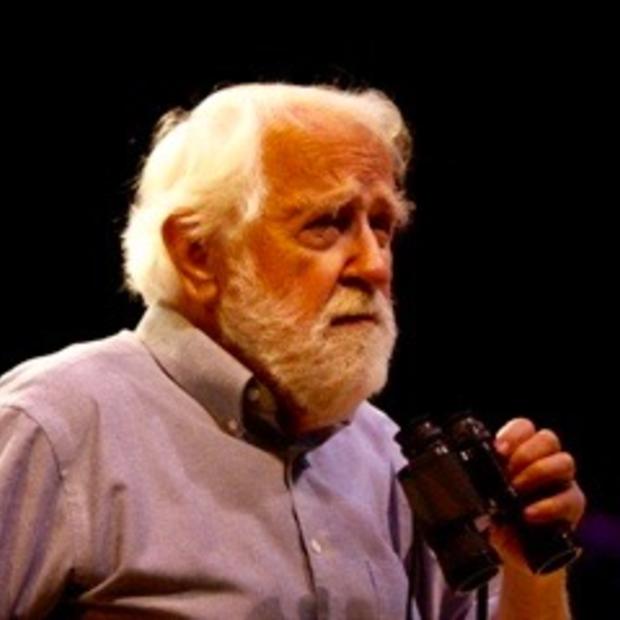Circling his two-ton ice sculpture the other day, artist Jyoti Duwadi talked about the ancient treasures it contains. “We’ve put fossils of all kinds in there,” he said, “some of them would have been under the ice sheets thousands of years ago. We’re hoping people — kids especially — will get excited about seeing them appear as the piece goes away.”
How soon it goes away will depend on the weather. The 4,000-pound work sits and melts in the courtyard of Whatcom Museum’s Lightcatcher building at Grand and Flora Streets in Bellingham. Battery powered diodes light the ice from the inside. It glows as a beacon for the first-of its kind art exhibition, titled "Vanishing Ice: Alpine and Polar Landscapes in Art, 1775-2012," which opened Sunday at the Museum at Grand and Flora Streets in Bellingham.

The Nepalese-born Duwadi has produced this sort of frozen sculpture before –- at the Kathmandu International Art Festival about a year ago, in the shadow of legendary and disappearing Himalayan glaciers. “That one lasted only about three days in the heat," he says. “Here, we’re hoping for at least a week before it disappears.”
You could say that the first snowflake of the exhibition began to form about 30 years ago. At the time, Barbara Matilsky, now Curator of the Whatcom Museum, was writing her doctoral dissertation (before she met and married Jyoti Duwadi) on the lives and landscapes of the early French artist-explorers. They were among the first to view and record the grandeur of polar regions and mountain glaciers. They functioned as the news reporters of their time, and the news was this: The extremes of the earth are not the dwellings of devils and monsters, as widely thought, but places of sublime beauty and inspiration.
“About 2005, I became aware that contemporary artists were returning to alpine and polar regions in great numbers,” Matilsky told Crosscut. “I imagined what it would look like to compare the work of the early artists to those of the 21st century.”
“I researched as many artists as I could find who worked in the decades in between. It’s such a vast subject I could present only a glimpse into the rich cultural history of the frozen frontiers.”
The exhibition features seventy art works from twelve countries, ranging in time from the first known close-up image of a glacier (drawn by Abraham Jager in 1601) to Olaf Otto Becker’s gorgeous and sorrowful photos of the melting Greenland Icecap in 2008. The early paintings provide some glorious benchmarks, against which today’s vanishing ice can be measured visually.
The comparisons are startling. Marc Theodore Bouritt’s 1786 engraving, “Le Mont Blanc vu en face de cote de l’allee blanche,” hangs beside Patricia Imhof’s 2009 photograph of the same location in the French Alps. Mount Blanc is no longer blanc — the “White Alley” is a sandy brown.


Top to bottom: Edward Oliver Wheeler, West Rongbuk Glacier, 1921, and David Breashears, West Ronbuk Glacier, Northern slope of Mt. Everest, 2008. Photos courtesy of Whatcom Museum.
Images of Canada’s Columbia Icefields, the largest ice mass in North America, show dramatic loss from the Athabascan and Saskatchewan Glaciers. If there’s any good news, it is that the northwest corner of the icefields — the region that gives life to the Columbia River and so much of Washington’s industry and agriculture — appears to be melting more slowly than the others.
Mt. Baker’s glaciers, among the hundreds that feed the Skagit River, have lost about twenty percent of their volume in the years since Eliot Porter made his 1975 color print of Coleman Glacier, which shares exhibit space at "Vanishing Ice," with Brett Baunton’s 2007 image from the same location.


Left to right: “Noctilucent clouds over Mount Baker, Washington, July 30, 1975,” by Eliot Porter. “Coleman Glacier, Mount Baker, 2007,” by Brett Baunton.
The exhibition’s theme could hardly be more timely for a Pacific Northwest venue. The year has been marked with water rights lawsuits in the Skagit, the Methow and Columbia River drainages, among others. These scuffles will only multiply and intensify as the North Cascade glaciers, a vast scattering of mountain mothers that nurse our rivers through hot summers and low flows, disappear at an increasing rate.
The Northwest is losing a great deal more than just inspirational scenery: Glaciers of the North Cascades provide 200 billion gallons of runoff every summer to the farms and cities of the lowlands, according to glacier scientist Mauri Pelto, director of North Cascades Glacier Climate Project. It isn’t just a matter of volume either. The glaciers function as cold water bank accounts, keeping the temperatures of lowland rivers cold enough for trout and salmon to survive.
Visitors to the Whatcom Museum will notice an extraordinary "Timeline of Vanishing Ice" that stretches across a wall, bringing the progression of loss sharply into context. It stretches from 1600 to the 21st Century, charting historic discoveries and inventions relating to today’s climate debate, and the loss of polar and mountain ice. It notes the earliest known theory of global warming (1824), as well as the latest measurement of carbon dioxide in the atmosphere: 400 parts per million — a 70 percent increase in 243 years.
If you go: "Vanishing Ice" at the Whatcom Museum, November 3, 2013 - March 2, 2014.


